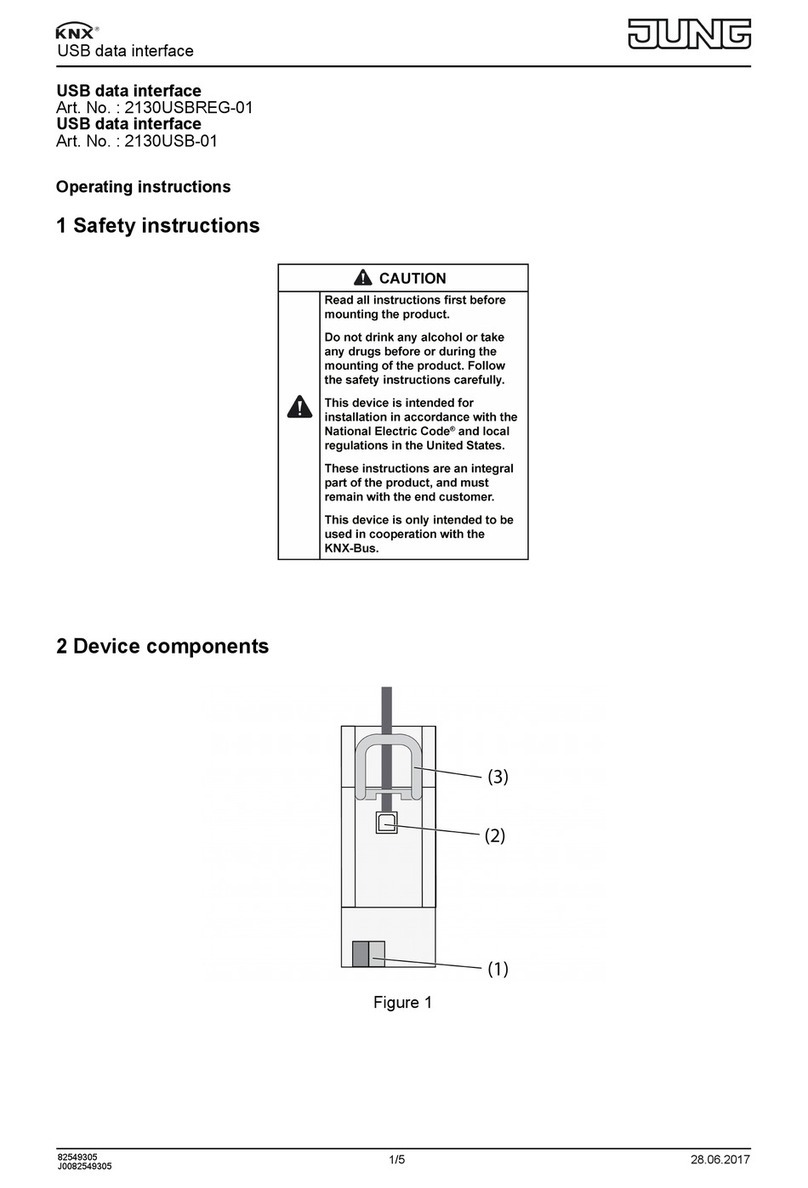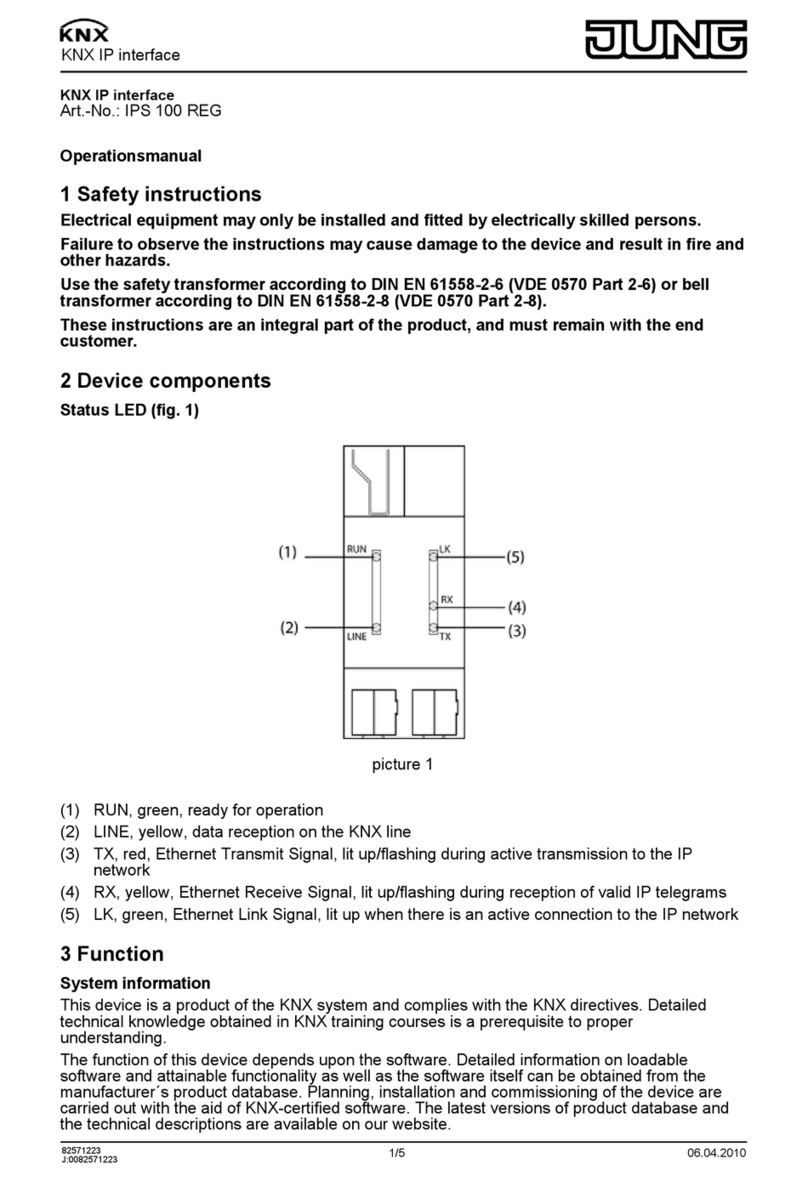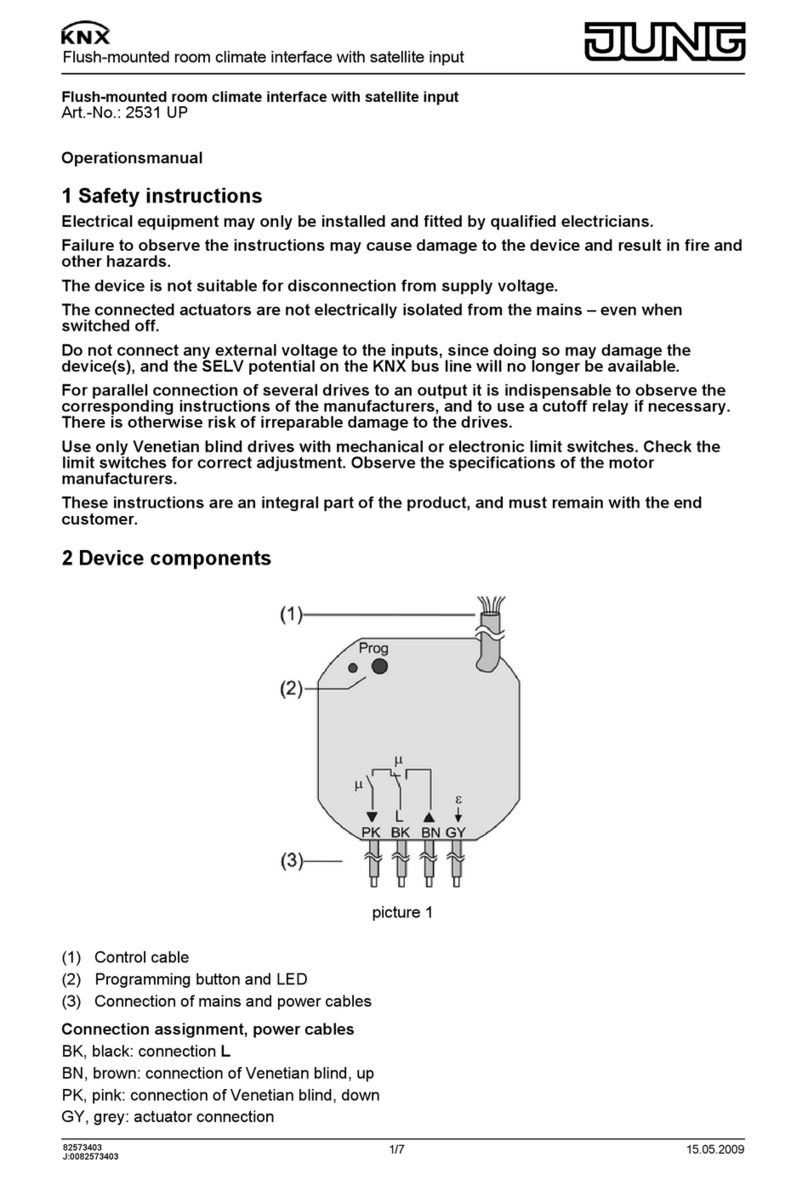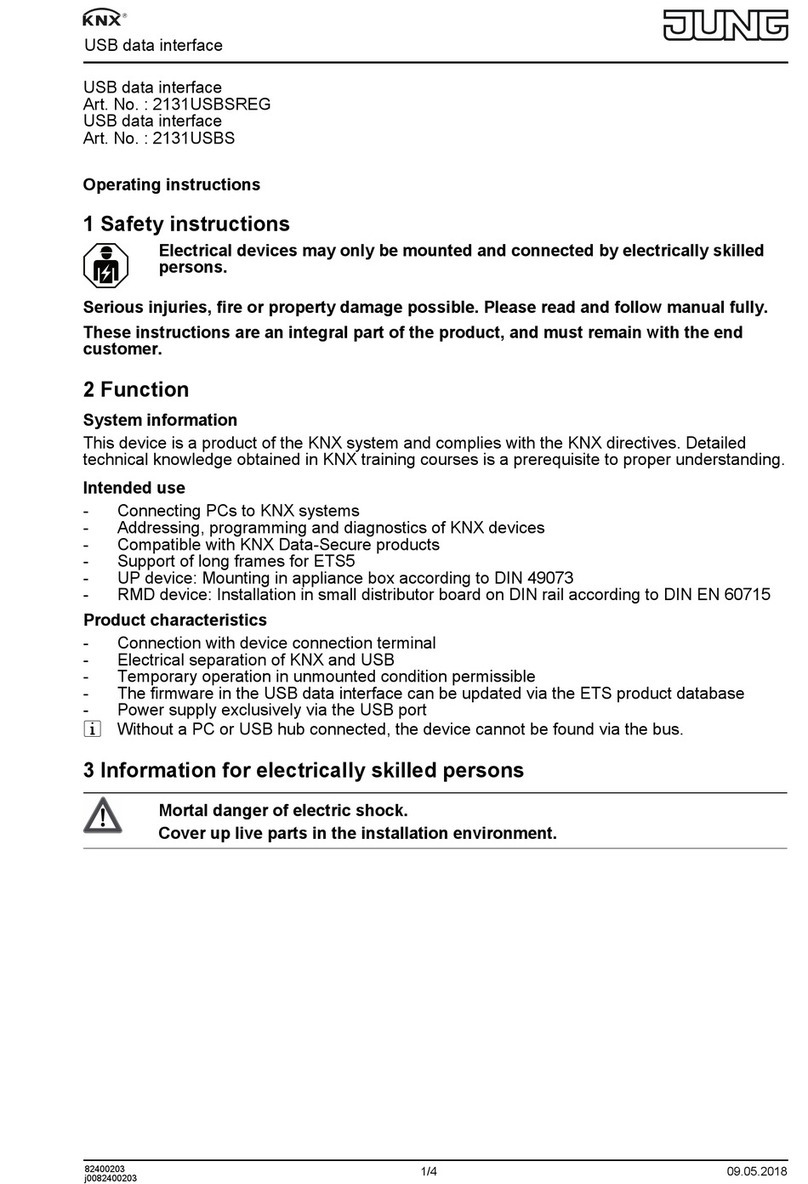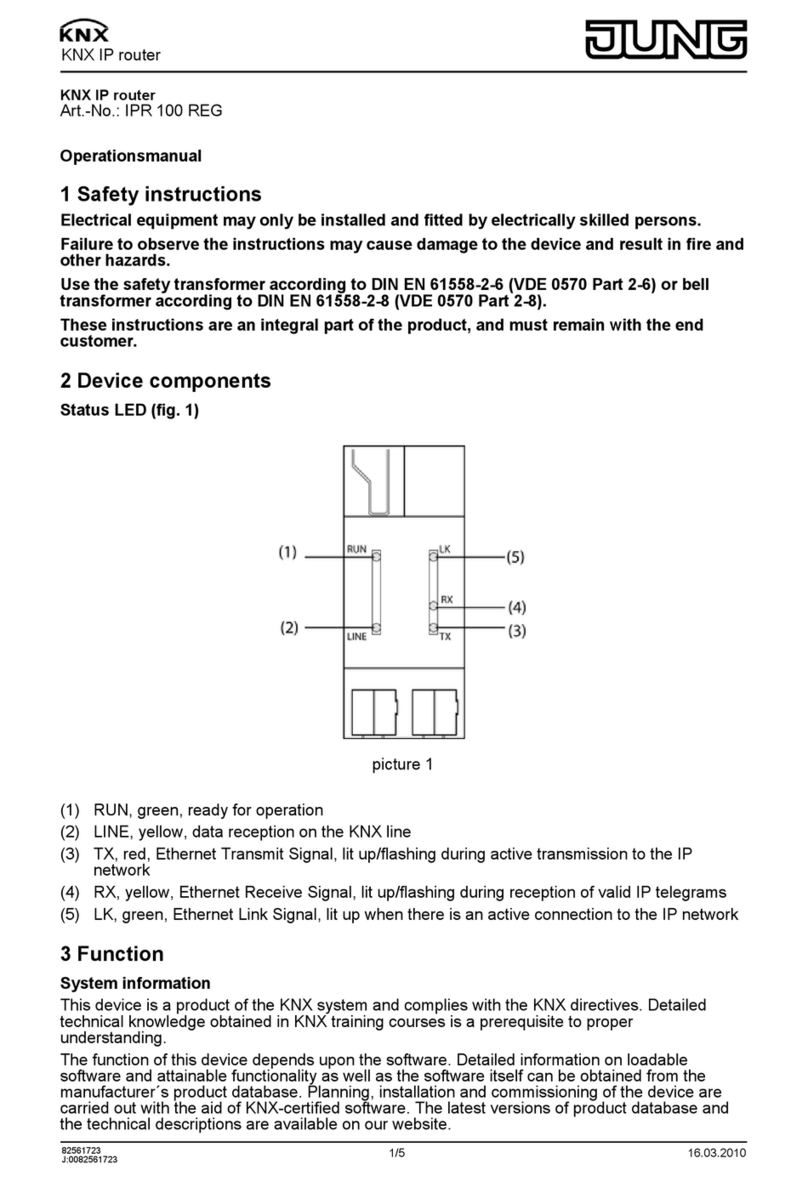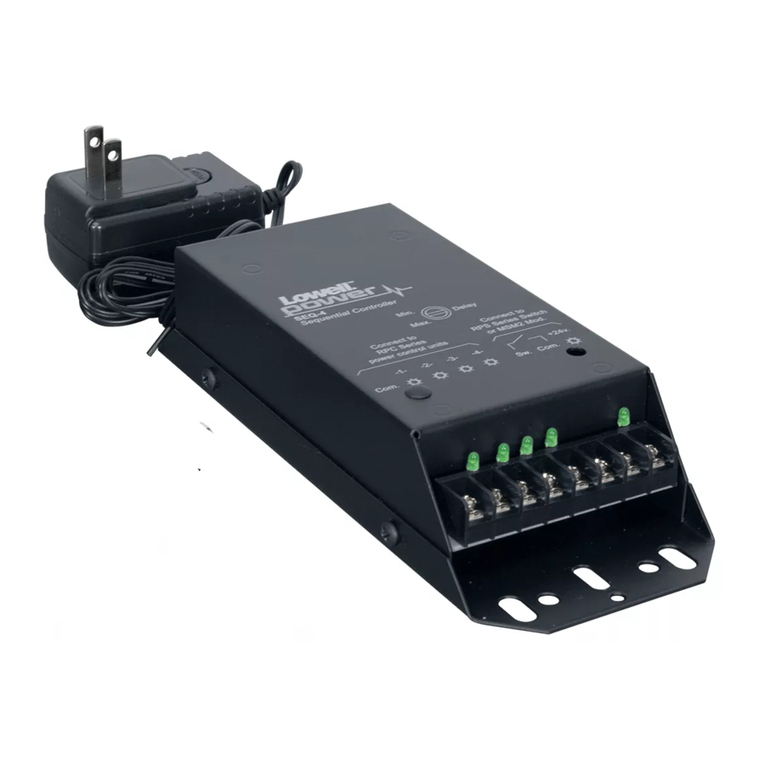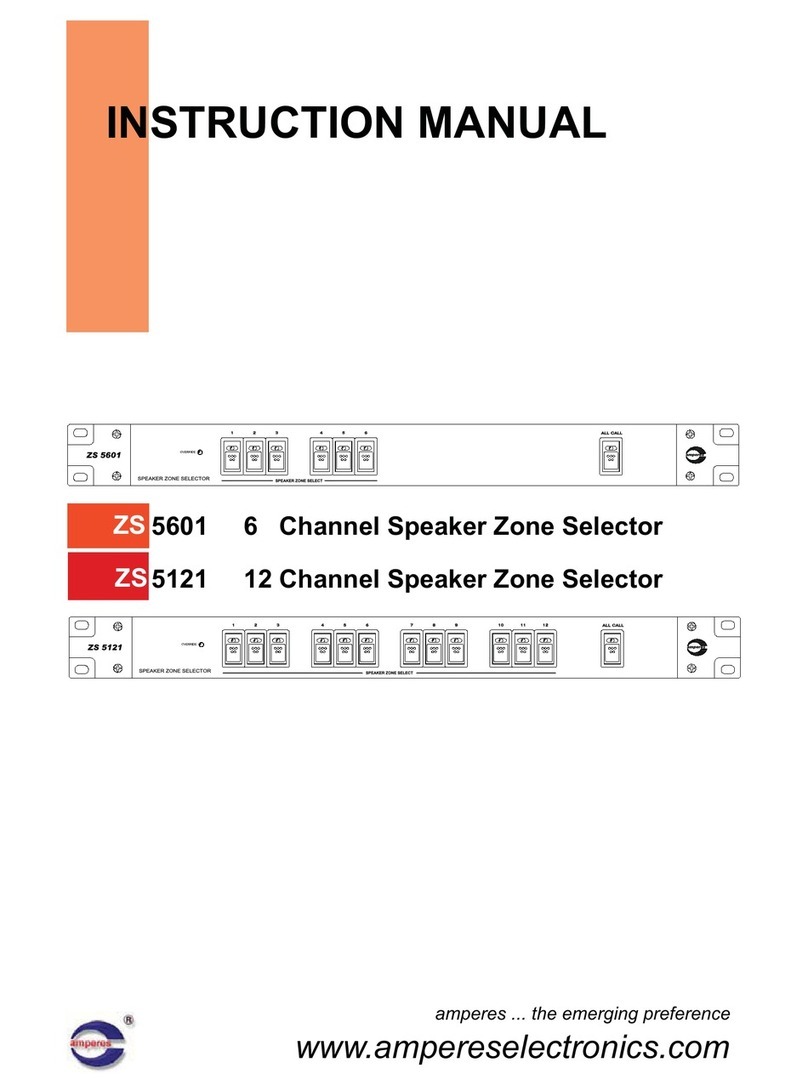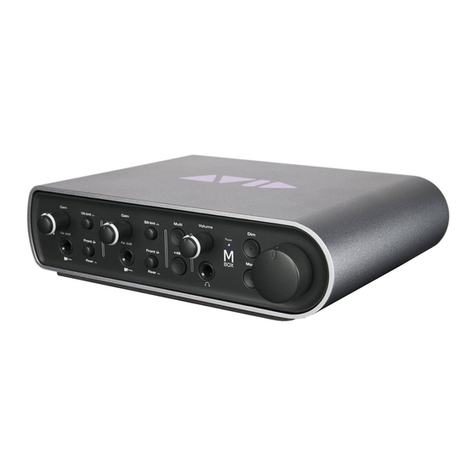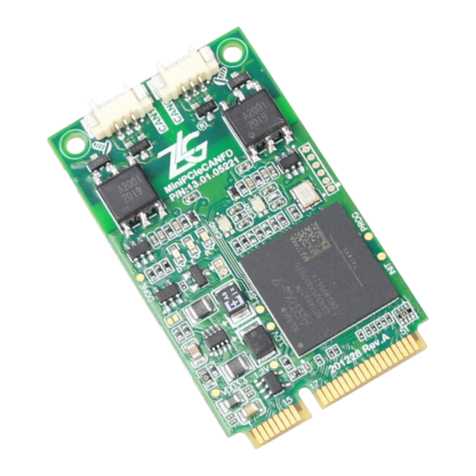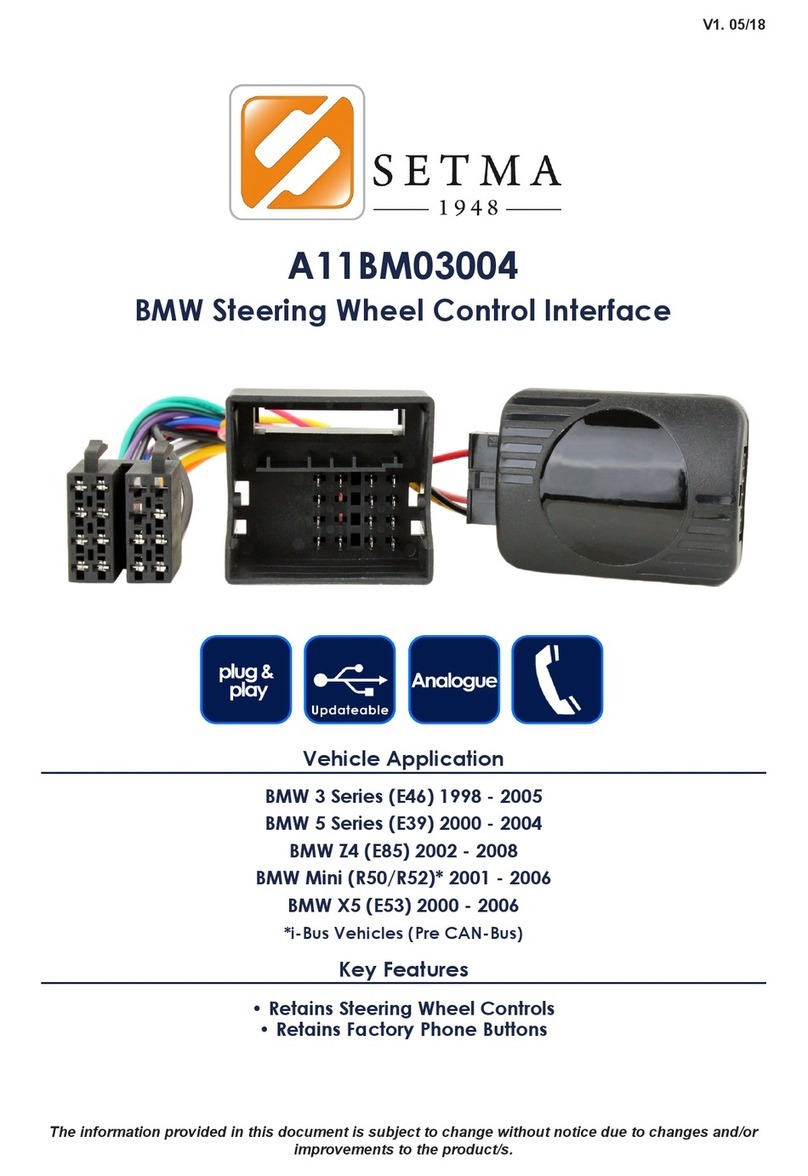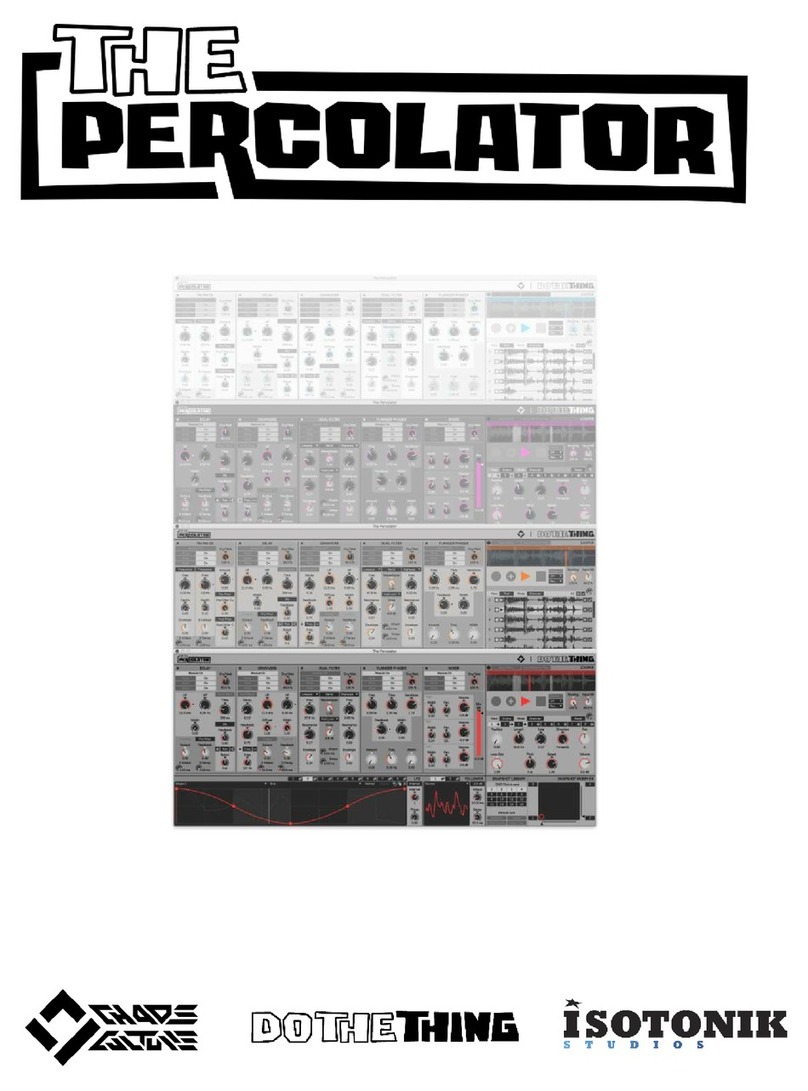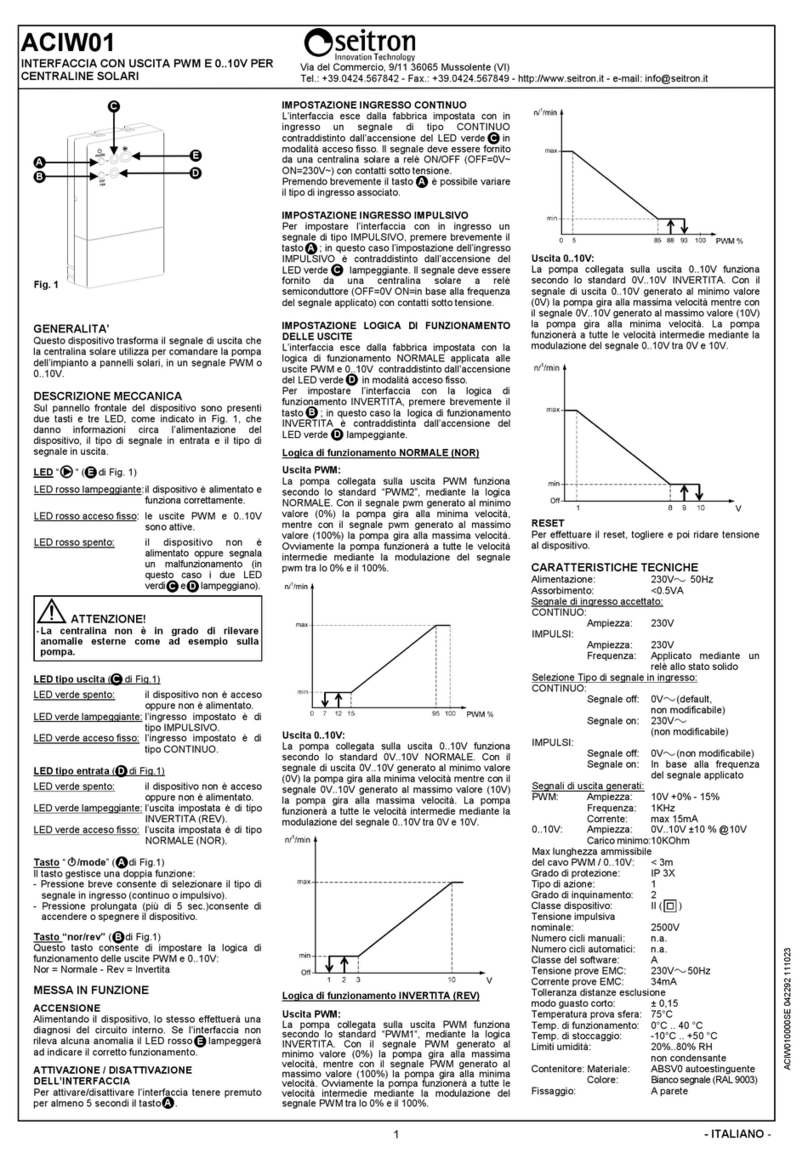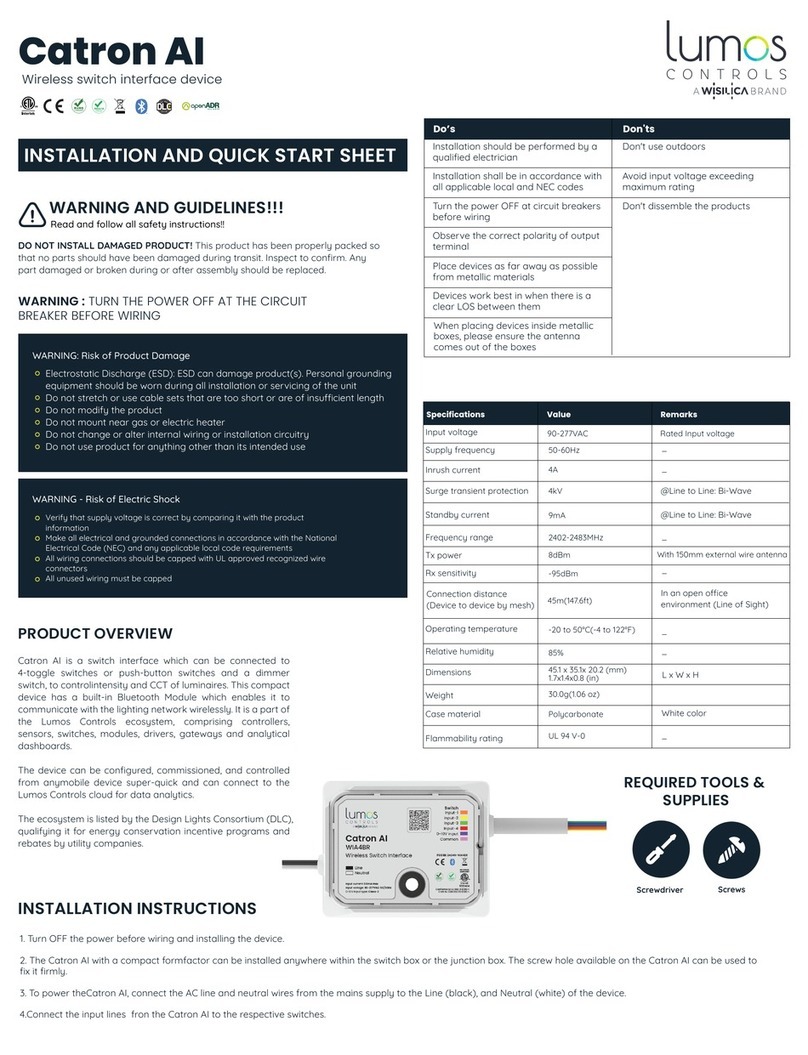Jung IPS 100 REG Operator's manual

Product documentation
KNX IP interface
Art.-No.: IPS 100 REG
ALBRECHT JUNG GMBH & CO. KG
Volmestraße 1
D-58579 Schalksmühle
Telefon: +49.23 55.8 06-0
Telefax: +49.23 55.8 06-1 89
E-mail: [email protected]
Internet: www.jung.de
www.jung-katalog.de Issue: 24.03.2010
64542312 R2

Art.-No.: IPS 100 REG
Content
1 Product definition 3 ................................................................................................................
1.1 Product catalogue 3 ...........................................................................................................
1.2 Function 3 ..........................................................................................................................
1.3 Accessories 4 ....................................................................................................................
2 Fitting, electrical connection and operation 5 .....................................................................
2.1 Safety instructions 5 ..........................................................................................................
2.2 Device components 6 ........................................................................................................
2.3 Fitting and electrical connection 7 .....................................................................................
2.4 Commissioning 11 .............................................................................................................
3 Technical data 12 ....................................................................................................................
4 Software description 13 .........................................................................................................
4.1 Software specification 13 ...................................................................................................
4.2 Software "IP interface 720001" 14 .....................................................................................
4.2.1 Scope of functions 14 .................................................................................................
4.2.2 Software information 15 .............................................................................................
4.2.3 Functional description 17 ...........................................................................................
4.2.4 Communication parameters in the ETS 18 ................................................................
4.2.5 Parameters 22 ............................................................................................................
5 Appendix 24 .............................................................................................................................
5.1 Index 24 .............................................................................................................................
Product documentation
Page 2 of 25

Art.-No.: IPS 100 REG
1 Product definition
1.1 Product catalogue
Product name: IP interface
Use: Interface
Form Rail-mounted device
Art.-No.: IPS 100 REG
1.2 Function
This product documentation describes the device with the release code "R2" on the device
label. Separate product documentation is available for older device variants (no release code).
The device serves as an interface to KNX installations via Ethernet data networks using the
Internet protocol (IP). This allows communication between KNW devices and PCs or other data
processing devices.
The connection to the KNX is set up using a bus connection terminal. The connection to the
data network (IP over 10BaseT) is made using a RJ45 socket. For operation, the device
requires an additional AC/DC 24 V power supply. This power supply can be added to the
interface via the network cable from "Power over Ethernet" according to IEEE 802.3af.
Alternatively, the additional power supply can be drawn from the second terminal block
(Recommendation: White-yellow connection terminal) from a safety extra-low voltage AC/DC 24
V or a bus voltage supply (unregulated voltage DC 30 V). When the external voltage supply is
connected to the second terminal block, the device switches automatically to this.
The device uses the KNXnet/IP tunnelling standard, meaning that telegrams can be sent to
KNX installations via an IP network, allowing bus access from a PC. Even if there is no direct
network connection between a PC and the device, KNX installations can be accessed remotely
using a LAN modem. LAN modems for analogue telephony, ISDN or DSL are available from
retail outlets.
The device can offer the following advantages...
- Simple connection to higher-level systems using the Internet protocol (IP),
- Direct access to the KNX installation from any point in the IP network (KNXnet/IP
tunneling).
- Communication between buildings and sites (e.g. networking of branch offices),
- Simple connection of visualisation systems and facility management systems.
The device offers up to 5 KNXnet/IP tunnelling connections, meaning that, for example,
visualisation and configuration with the ETS3 are possible simultaneously.
A data network can be used to set up a direct connection from a PC in the network to the bus,
also via an ObjectServer. Compared with KNXnet/IP tunnelling, an ObjectServer has the
advantage that communication is still maintained via such network connections, in which the
signal runtime takes longer than a second (e.g. satellite connections).
The front of the device has LED displays to signal readiness, KNX communication and IP
communication. Due to the supported KNX standard, the device can be configured simply and
put into operation via the ETS.
Page 3 of 25
Product definition

Art.-No.: IPS 100 REG
2 Fitting, electrical connection and operation
2.1 Safety instructions
Electrical devices may only be fitted and installed by electrically skilled persons. The
applicable accident prevention regulations must be observed.
Failure to observe the instructions may cause damage to the device and result in fire and
other hazards.
Use the safety transformer according to DIN EN 61558-2-6 (VDE 0570 Part 2-6) or bell
transformer according to DIN EN 61558-2-8 (VDE 0570 Part 2-8).
Page 5 of 25
Fitting, electrical connection and operation

Art.-No.: IPS 100 REG
2.2 Device components
picture 1: Device components
(1) KNX bus connection
(2) Connection for additional AC/DC 24 V power supply
(3) Connection for Ethernet data network / LAN (RJ45 socket)
(4) LED "RUN" (green)
Signals readiness (additional power supply switched on).
(5) LED "LINE" (yellow)
Lights up briefly when data is received at the KNX bus connection.
(6) LED "LK" (green)
Signals an active connection to the IP data network (Ethernet Link).
(7) LED "RX" (yellow)
Briefly lit up during reception of valid IP telegrams (Ethernet Receive).
(8) LED "TX" (red)
Briefly lights up on transmitting IP telegrams (Ethernet Transmit)
If the programming button (10) is actuated, the "TX" LED signals the type of IP address
assignment to the device for 10 seconds:
1x flash: Fixed IP address
2x flash: DHCP
3x flash: AutoIP
(9) Programming LED (red)
(10) Programming button
Page 6 of 25
Fitting, electrical connection and operation

Art.-No.: IPS 100 REG
2.3 Fitting and electrical connection
DANGER!
Electrical shock when live parts are touched.
Electrical shocks can be fatal.
Before working on the device, disengage all the corresponding miniature
circuit breakers. Cover up live parts in the working environment.
DANGER!
The additionally connected low voltage supply is connected to the LAN
potential through the device.
This means that there is no more insulation to the earth (no SELV!) when the
LAN shield is earthed.
Do not use any KNX supply voltage as an additional power supply, if a bus line
is also connected to this power supply.
Recommendation: only use the additional power supply for the device.
Fitting the device
o Snap onto DIN rail to DIN EN 60715. Observe the installation position (picture 2).
i A KNX/EIB data rail is not required.
Connecting the device for the bus line and power supply
o Connect the bus (standard bus terminal) and the connection of the power supply according
to the connection diagrams. Power supply either from the network cable "Power over
Ethernet" according to IEEE 802.3af - or through the external power supply via the second
terminal block (Recommendation: White-yellow connection terminal). When the external
voltage supply is connected, the device switches automatically to this.
Page 7 of 25
Fitting, electrical connection and operation

Art.-No.: IPS 100 REG
picture 2: Electrical connection of the bus line and the external power supply
Connection example with additional power supply (e.g. suitable bell transformer)
Page 8 of 25
Fitting, electrical connection and operation

Art.-No.: IPS 100 REG
picture 3: Electrical connection of the bus line and the external power supply
Connection example with KNX bus voltage supply
(11) IP interface
(12) Separate SELV power supply (e.g. suitable bell transformer or accessories)
(13) Ethernet connection point (e.g. switch, router or PC)
(14) Ethernet connection cable (e.g. Patch cable)
(15) KNX power supply
o Connect the external power supply AC/DC 24 V to the connection terminal (2).
Recommendation: Use the white-yellow connection terminal.
o Connect the KNX bus line to the red and black bus terminal (1).
o IP connection with RJ45 connector plugged into RJ socket (3).
i There is a physical connection to the data network when the green LED "LK" (6) is lit up
permanently.
If the yellow LED "RX" (7) is lit up, the device is receiving data from the network.
If the red LED "TX" (8) is lit up, the device is transmitting data to the network.
i Depending on application, access requirements, data security and data volume it may be
advisable to install independent network paths for individual services using the IP network.
Page 9 of 25
Fitting, electrical connection and operation

Art.-No.: IPS 100 REG
i The KNX bus connection and the terminal block for the external power supply are
galvanically separated from the Ethernet connection.
Page 10 of 25
Fitting, electrical connection and operation

Art.-No.: IPS 100 REG
2.4 Commissioning
Loading the physical address and application software
The commissioning of the device is basically confined to programming of the physical address
and the application data with the ETS.
Project planning and commissioning of the device using the ETS 2, Version 1.2 or higher.
The device is connected and ready for operation.
An appropriate device must be created and configured in the ETS project.
o Activating Programming mode: press the programming button (10) (picture 1).
The programming LED (9) is illuminated.
o Program the physical address with the help of the ETS.
The programming LED goes out.
o Write the physical address on the device label.
o Load the application data into the device using the ETS.
i The IP address is loaded into the device as a parameter together with the application data
or is assigned automatically by a DHCP service. If the DHCP function is activated and the
DHCP service is missing, then the device automatically assigns itself an IP address using
AutoIP.
i After commissioning, the device can be restored to the delivery state by switching on the
external power supply and pressing and holding down the Programming button for longer
than 6 seconds. The transition to the delivery state is displayed by the Programming LED
flashing rapidly. This operation causes all the parameter settings to be deleted.
Assigning additional physical addresses
For communication via KNXnet/IP tunnelling and ObjectServer, the device must use a virtual
physical address for each connection. These additional physical addresses may not be identical
to the physical address of the device and may not be used by any other bus device. In the ETS,
the virtual physical addresses should be assigned to dummy devices.
The additional addresses for the KNXnet/IP tunnelling can be assigned either manually in the
ETS using the communication settings (see chapter 4.2.4. Communication parameters in the
ETS) or automatically by the device itself. Addresses are assigned automatically by pressing
the Programming button on the device.
o With the power supply switched on, press the Programming button (10) for between 5 and
10 seconds.
The red programming LED (9) flashes.
The device sporadically selects physical addresses and checks whether the addresses in
the bus line are still free. The device automatically assigns up to 5 virtual physical
addresses in this way.
The programming LED goes out at the end of the operation.
i If additional bus devices are added to the installation at a later time, one or all of the virtual
physical addresses may be assigned twice. In this case, the automatically assigned
addresses must be deleted. Deletion takes place automatically when the Programming
button (10) on the device is pressed for longer than 10 seconds. All the addresses are then
set to the default value 15.15.255 and the programming LED goes out (9). New address
assignment is then possible.
Page 11 of 25
Fitting, electrical connection and operation

Art.-No.: IPS 100 REG
3 Technical data
General
Ambient temperature -5 ... +45 °C
Storage/transport temperature -25 ... +70 °C
Relative humidity 5 ... 93 % (No moisture condensation)
Fitting width 36 mm / 2 modules
Weight approx. 100 g
KNX "BUS" supply
KNX medium TP 1
Commissioning mode S mode
Rated voltage KNX DC 21 V ... 32 V SELV
Current consumption KNX max. 10 mA
Connection mode KNX Connection terminal
External supply
Rated voltage AC 12 ... 24 V SELV
Rated voltage DC 12 ... 30 V SELV
Power consumption max. 1.7 W
Connection of power supply Connection terminal
Power-over-Ethernet power supply
Power over Ethernet IEEE802.3af
Rated voltage DC 48 V
Power consumption max. 0.8 W
IP
IP connection mode RJ45 socket
IP communication Ethernet 10BaseT
IP transmission rate 10 Mbit/s
Protocols ARP, ICMP, IGMP, UDP/IP, DHCP
KNXnet/IP Core, Tunneling, Device Management
Page 12 of 25
Technical data

Art.-No.: IPS 100 REG
4 Software description
4.1 Software specification
ETS search paths: Communication / IP / IP interface
Configuration: S-mode standard
PEI type: "00"Hex / "0" Dec
PEI connector: No connector
Application program:
No. Short description Name Version from mask
version
1 Data interface KNXnet/IP IP interface 720001 0.1 1.2
Page 13 of 25
Software specification

Art.-No.: IPS 100 REG
4.2 Software "IP interface 720001"
4.2.1 Scope of functions
- Simple connection to higher-level network systems using the Internet protocol (IP),
- Direct access to the KNX installation from any point in the IP network (KNXnet/IP
tunnelling). Use as a data interface to program KNX bus devices or to record telegrams (no
bus monitor mode) from ETS 3.0c or higher.
- Simple connection of visualisation systems and facility management systems.
- Communication between buildings and sites (e.g. networking of sites).
- Simple parameter configuration and commissioning (device programming via the bus)
using ETS 2, Version 1.2 or higher, or ETS 3.
Page 14 of 25
Software "IP interface 720001"
Scope of functions

Art.-No.: IPS 100 REG
4.2.2 Software information
ETS
Using the device:
ETS 3 (Version 3.0c or higher) permits the configuration of KNX installations via the existing IP
data network, by using the device with the KNXnet/IP protocol as a standard serial RS232 or
USB data interface for communication with the bus. This also includes the download of bus
devices or the function of the group bus monitor (no support of bus monitor mode). In older
versions of ETS 3 or in ETS 2, the device cannot be used as data interface.
The data interface is configured in the ETS using a dialog for setting the communication
parameters. The virtual physical address for KNXnet/IP tunnelling can also be assigned
automatically during commissioning .
i With some versions of ETS 3, it may occur that, after installing the communication driver
and enabling the communication interface, a Windows error message will appear, stating
that the "Class" is unknown. In this case, install the Microsoft .NET Framework, which can
be downloaded from the Microsoft Update website (file size: approx. 25 MB).
i Unloading from the device using the ETS may terminate with the error message
"An internal error has occurred". Then no other bus subscriber can be programmed using
the device. On checking the "Settings" in the menu "Tools -> Options -> Communication"
the error message "Serious Error" appears. To eliminate the error, either select a different
interface or exit the ETS and restart it.
i Should the communication with the bus fail in an existing KNXnet/IP tunnelling connection,
then no connection to the bus can be set up, even when the bus voltage returns. Attempts
to program will fail. In such cases, either select a different interface or exit the ETS. Only
afterwards will it be possible to set up a connection using the previously used IP device.
The same behaviour occurs if the power supply to the device fails.
i If the device is used as the active data interface and the internal application program of the
device is loaded via the bus, then the ETS error message
"Cannot find the device with the physical address %1" will appear. The download is not
carried out. Either select a different interface or exit the ETS first. Only afterwards will it be
possible to set up a connection using the previously used IP device.
Configuring the device in the ETS:
The ETS application program of the device has several parameters for device and IP
configuration (see chapter 4.2.5. Parameters). During commissioning, the application program
must be loaded into the device using the ETS (see chapter 2.4. Commissioning). It is possible
to configure the parameters and load the application into the devices via the bus from ETS 2,
Version 1.2.
i The ETS 3 driver does not support the bus monitor and download to local device functions.
When a local download to the device is attempted, the following message appears:
"Incompatible BCU Version $091A ($0012 required)".
Delivery state
When delivered, the physical addresses of the device are preset to 15.15.255. The IP address
is assigned automatically by DHCP. If there is no DHCP server in the data network, then the
device will assign itself an IP address using AutoIP.
After commissioning, the device can be restored to the delivery state by switching on the
external power supply and pressing and holding down the Programming button for longer than 6
seconds. The transition to the delivery state is displayed by the Programming LED flashing
rapidly. This operation causes all the parameter settings to be deleted.
Page 15 of 25
Software "IP interface 720001"
Software information

Art.-No.: IPS 100 REG
Note on this product documentation
This product documentation describes the device with the release code "R2" on the device
label. Separate product documentation is available for older device variants (no release code).
Page 16 of 25
Software "IP interface 720001"
Software information

Art.-No.: IPS 100 REG
4.2.3 Functional description
Use and configuration
A direct connection between a PC or other data processing devices (e.g. visualisations) in the
network can be set up for KNX installation using an IP data network and the device. This means
that it is possible to access the bus from any point in the IP data network.
ETS 3 (Version 3.0c or higher) permits the configuration of KNX installations via the existing IP
data network, by using the device with the KNXnet/IP protocol as a standard serial RS232 or
USB data interface for communication with the bus. This also includes the download of bus
devices or the function of the group bus monitor (no support of bus monitor mode).
The data interface is configured in the ETS 3 using a dialog for setting the communication
parameters.
Assignment of the IP addresses
The IP addresses of the device are assigned in the ETS configuration or automatically by a
DHCP service in the IP network. Assignment by a DHCP service allows changes to the IP
addresses without device configuration using the ETS. If no DHCP service is available, then the
device will search for its own IP address (AutoIP).
If there are questions regarding the setting of the IP parameters of the device or the DHCP,
then please contact the local network administrator.
i If the Programming button is pressed on the device, the "TX" LED signals the type of IP
address assignment to the device for 10 seconds:
1x flash: Fixed IP address
2x flash: DHCP
3x flash: AutoIP
Page 17 of 25
Software "IP interface 720001"
Functional description

Art.-No.: IPS 100 REG
4.2.4 Communication parameters in the ETS
For communication via KNXnet/IP tunnelling and ObjectServer, the device must use a virtual
physical address for each connection. These additional physical addresses may not be identical
to the physical address of the device and may not be used by any other bus device. In the ETS,
the virtual physical addresses should be assigned to dummy devices.
The additional addresses for the KNXnet/IP tunnelling can be assigned either manually in the
ETS using the communication settings or automatically by the device itself (see page 11). Run
through the following three steps to configure the communication interface in the ETS 3...
1.
Firstly, start the ETS and open the Options dialog of the communication properties. Do this with
the program menu "Tools -> Options -> Communication" (picture 4).
picture 4: Options dialog of the communication properties of ETS3
2.
Select the "Configure interface" button. The "ETS Connection Manager" window opens
(picture 5).
Page 18 of 25
Software "IP interface 720001"
Communication parameters in the ETS

Art.-No.: IPS 100 REG
picture 5: ETS Connection Manager
3.
Create a new connection. Then press the "New" button. Give the new connection a unique
name. Select "Eibnet/IP" as the type (picture 6). Then ETS will search the IP data network
automatically for available IP communication devices.
picture 6: Creating the new connection as EIBnet/IP
Page 19 of 25
Software "IP interface 720001"
Communication parameters in the ETS

Art.-No.: IPS 100 REG
4.
The "Eibnet/IP device" device list contains all the KNX IP devices found in the IP network
(picture 7). The device name and the IP address are displayed. The (P) behind this data
indicates an activated Programming mode. In this way, individual KNX IP device can be
identified in a targeted manner, even in large systems. In the device list, select that device
which is to work as the "Device interface" in the configured connection. Clicking the "Rescan"
button causes the ETS to start an additional scan, which will then rescan the IP network for
KNX IP devices.
Then, the configuration of the new connection can be completed by clicking the "OK" button.
The communication parameters should remain unchanged.
picture 7: Device list under Communication Parameters with all the KNX IP devices found
5.
For stable communication via KNXnet/IP tunnelling, the device must have a virtual physical
address for each connection (similar to the local physical address with a RS232 or USB
connection). For this, select the new KNXnet/IP connection as the interface in the Options
dialog of the Communication parameters (picture 8) and click the "Settings" button.
Page 20 of 25
Software "IP interface 720001"
Communication parameters in the ETS
Other manuals for IPS 100 REG
1
Table of contents
Other Jung Recording Equipment manuals
Popular Recording Equipment manuals by other brands

Mitsubishi Electric
Mitsubishi Electric MELSEC iQ-R Series user manual
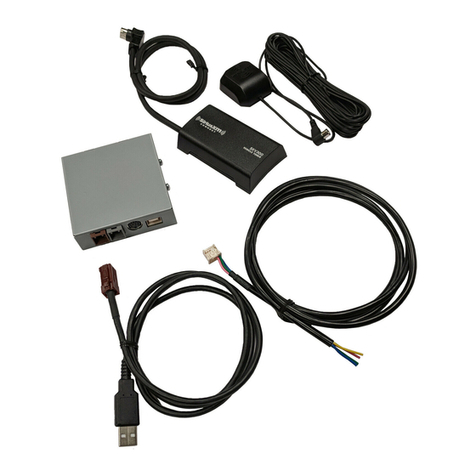
Vais Technology
Vais Technology GSR SiriusXM SXV300 owner's manual

Eventide
Eventide Misha Quick reference guide
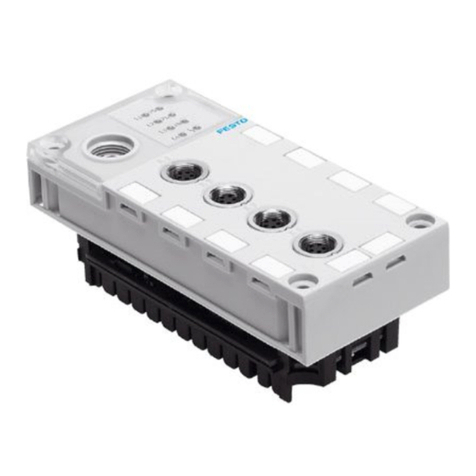
Festo
Festo CPX-CP-4-FB Brief description
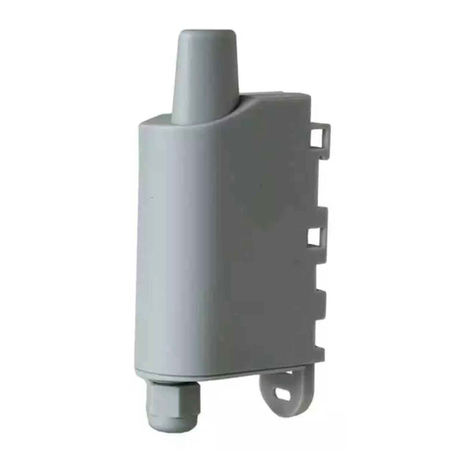
Adeunis RF
Adeunis RF DRY CONTACTS V2 LoRaWAN 863-870 user guide
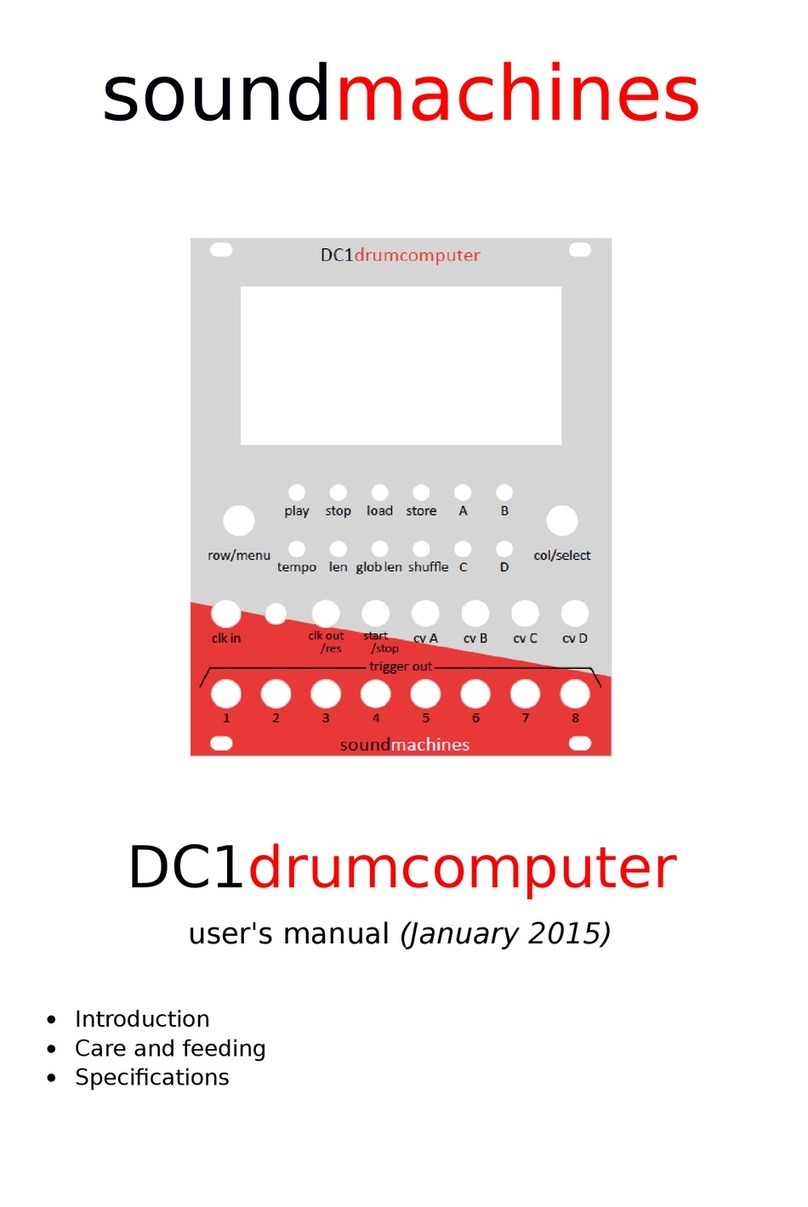
Soundmachines
Soundmachines DC1drumcomputer user manual

